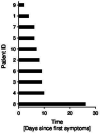Famotidine use and quantitative symptom tracking for COVID-19 in non-hospitalised patients: a case series
- PMID: 32499303
- PMCID: PMC7299656
- DOI: 10.1136/gutjnl-2020-321852
Famotidine use and quantitative symptom tracking for COVID-19 in non-hospitalised patients: a case series
Abstract
Objective: Treatment options for non-hospitalised patients with coronavirus disease 2019 (COVID-19) to reduce morbidity, mortality and spread of the disease are an urgent global need. The over-the-counter histamine-2 receptor antagonist famotidine is a putative therapy for COVID-19. We quantitively assessed longitudinal changes in patient reported outcome measures in non-hospitalised patients with COVID-19 who self-administered high-dose famotidine orally.
Design: Patients were enrolled consecutively after signing written informed consent. Data on demographics, COVID-19 diagnosis, famotidine use, drug-related side effects, temperature measurements, oxygen saturations and symptom scores were obtained using questionnaires and telephone interviews. Based on a National Institute of Health (NIH)-endorsed Protocol to research Patient Experience of COVID-19, we collected longitudinal severity scores of five symptoms (cough, shortness of breath, fatigue, headaches and anosmia) and general unwellness on a four-point ordinal scale modelled on performance status scoring. All data are reported at the patient level. Longitudinal combined normalised symptom scores were statistically compared.
Results: Ten consecutive patients with COVID-19 who self-administered high-dose oral famotidine were identified. The most frequently used famotidine regimen was 80 mg three times daily (n=6) for a median of 11 days (range: 5-21 days). Famotidine was well tolerated. All patients reported marked improvements of disease related symptoms after starting famotidine. The combined symptom score improved significantly within 24 hours of starting famotidine and peripheral oxygen saturation (n=2) and device recorded activity (n=1) increased.
Conclusions: The results of this case series suggest that high-dose oral famotidine is well tolerated and associated with improved patient-reported outcomes in non-hospitalised patients with COVID-19.
Keywords: COVID-19; COVID-19 symptoms; Famotidine; PROMs; SARS-CoV-2; coronavirus; outpatients.
© Author(s) (or their employer(s)) 2020. Re-use permitted under CC BY-NC. No commercial re-use. See rights and permissions. Published by BMJ.
Conflict of interest statement
Competing interests: None declared.
Figures




References
-
- Food and Drug Agency Information Sheet on Famotidine Reference ID: 4280861, 1986. Available: https://www.accessdata.fda.gov/drugsatfda_docs/label/2018/019462s039lbl.pdf [Accessed 16 May 2020].
-
- Harris P. All of US research program Covid-19 participant experience (cope) survey (PPi), 2020. Available: https://www.phenxtoolkit.org/toolkit_content/PDF/NIH_COPE.pdf [Accessed 16 May 2020].
Publication types
MeSH terms
Substances
Grants and funding
LinkOut - more resources
Full Text Sources
Other Literature Sources
Medical
Miscellaneous
